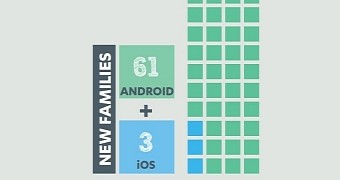A research focusing on the latest trends and developments in mobile malware for Android and iOS shows that 95% of the new malware families were created for Google’s platform.
F-Secure crunched the numbers from information available in the second half of 2014. The study took into consideration only unique variants, leaving aside installers that had been repackaged, and malware with multiple components have been counted as one piece.
Ransomware is the most prevalent threat on Android
Among the highlights of the report are Koler and Slocker, two malware families targeting Android users, which extort money from the victim in exchange for relinquishing control of the device.
The first one relies on scareware tactics by displaying a message purporting to be from a law enforcement agency and asking payment of a fine as a result of illegal material having been detected on the mobile terminal.
Slocker, on the other hand, is more dangerous as it encrypts the data on the device and demands payment to unlock it.
Two variants of Koler and Slocker are also present on the list of most prevalent malware for Android in H2 2014.
Another prevalent threat is Svpeng, whose author has allegedly been caught by Russian authorities. It resorts to phishing to grab login credentials for bank accounts, but some variants use ransomware tactics to get the money from the victim.
Jailbroken or not, iOS devices are susceptible to malware
In the case of iOS, F-Secure lists only 3 new threats that emerged between July and December 2014. One is an exploit for a vulnerability (CVE-2014-4377) in iOS 7.1.x via a malicious PDF file.
Wirelurker is the second noteworthy threat on iOS. It reaches the mobile device (regardless if it is jailbroken or not) via systems running OS X.
The third menace is Xsser mRAT, which can collect information from the compromised device, such as SMS, photos and contacts.
Despite Android being the preferred target for cybercriminals, malware infections for this platform are not a problem, according to Google’s first security report for Android.
A recent research from Damballa presented at the RSA security conference in San Francisco supports Google’s findings and reveals that malware communication from mobile devices in the US occurs only in 0.0064% of the monitored terminals (an average of 151,858,362).

 14 DAY TRIAL //
14 DAY TRIAL //